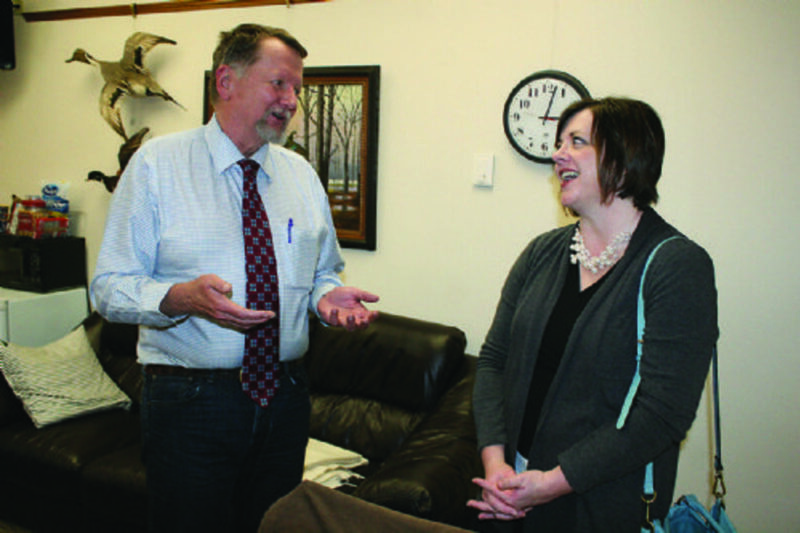Sean C. Morgan
Staff and students from school districts across the mid-Willamette Valley, including Sweet Home School District, testified Thursday against a bill they believe endangers a program that has drastically increased the number of high school graduates who move on to community college.
When seniors are eligible to graduate, they defer receiving their diplomas and remain enrolled in the School District. The district receives state education funds for these students based on “aggregate days membership,” the total number of days present and absent, in the district. The district pays tuition at the local community college, Linn-Benton Community College in Sweet Home’s case. The district also provides support for the students as they navigate their way through college for the first time. It is referred to as a “fifth-year program.”
Senate Bill 322 could end the practice but is supposed to provide alternative funding mechanisms for students participating in these programs.
Some 90 percent of Sweet Home citizens do not have a bachelor’s degree, said Kristin Adams, who is now overseeing the local program. One hundred percent of elementary students and 58 percent of secondary students are part of the free lunch program. Sweet Home has the fourth-largest percentage of homeless among school districts serving 1,000 students or more.
“We are an economy that has plummeted with the closure of sawmills and forest-related operations,” Adams said. “Our parents have no knowledge or experience as to how to access a college education and sometimes do not even understand the absolute need of post-secondary training that will allow their child to prosper in a struggling economy.”
Sweet Home High School Principal Pat Stineff said that even with this program in place, some students don’t take advantage of it based on that lack of knowledge. When a student may be the first to earn a diploma, the student’s parents insist they receive their diploma and miss out entirely on the opportunity to start college.
Overall, the program has radically increased the number of students moving on to community college.
“Since implementing our fifth-year program, we have gone from 19 percent of high school graduates attending a community college in 2010 to 55 percent in 2014,” Adams said. “This dramatic increase is highly due to the added support we have been able to give our students through the fifth-year program.”
“I think it’s a great program,” said Sweet Home Board Chairman Mike Reynolds. “It gives kids an opportunity to go on to college that otherwise might not do so.”
It’s a way to get at the state’s goal of 40-40-20, 40 percent earning a bachelor’s degree and 40 percent earning an associate’s degree or certificate, said Supt. Keith Winslow, who was present but did not testify Thursday. “We’ve come up with a pretty creative way to help our kids get started the first year for free.”
The district offers support that helps them be successful that first year in college, Winslow said. This year, some 70 students are in the program. Of those, probably 40 would not have gone on to community college without the program.
The people in the Portland area districts talk about equity, Winslow said. “We haven’t had equity in our school system for years. Rural districts have always taken it the hardest.”
One student testified that it takes money to make money.
He was right, Winslow said. It pays off in the long run. It will help the economy in the long run.
“I’ve seen it make a difference for a lot of kids who wouldn’t be going otherwise,” Stineff said.
“We feel very, very strongly about protecting this program,” Winslow said. He would like to see this committee kill this bill and then go to the table to come up with a solution that helps everyone, something equitable for rural districts.
It will help students like senior Kevin Seiber, who plans to enter the program next year.
In his case, he would continue on to college regardless of whether the program continues, but it’s something that can make college more affordable.
“I do think it’s important to keep,” he said. It gives students a free year to try college, to see how they can do.
And the students don’t need to incur so much debt going to college, Seiber said.
This program takes advantage of a loophole to use K-12 funding for tuition, said Sen. Mark Hass of Beaverton, a member of the Senate Committe on Education, which received public testimony on the bill Thursday at the capitol. The 20 districts doing this will cost $19 million in the next biennium.
“If all school districts did this, the system would crash,” Hass said.
Supporters and opponents of SB 322 have miles and miles of common ground, Hass said. “we’re all after the same thing.”
The alternative is to use Pell grant money to help fund these kinds of programs, he said.
“It was reported in the Oregonian this past weekend that rural districts with fifth-year programs were ‘robbing’ the K-12 budget, and it was unfair,” Adams said. “I believe that when you are evaluating fairness, one should compare apples-to-apples.”
She pointed to Beaverton’s English as a second language students who are counted as 1.5 for average daily membership, a total of $9,750 in state funding, compared to a poverty school, funded at 1.25 average daily membership, a total of $7,125 in state funds.
“I would think in all fairness, we could lower ESL ADM to 1.25 and probably pay for the entire fifth-year program in the State of Oregon from the savings we would see from Beaverton School District alone, almost $7.5 million,” Adams said. “I’m not sure if ESL programs can show the same success as fifth-year programs.”
She wasn’t testifying to cut English language learning programs, she said. “What I want is the Educational Committee to truly understand the use of the word ‘fair’ when it comes to state school funding. It should not be about equity of investment. It should be equity in outcome. The fifth-year programs are in place to bring an equitable outcome for post-secondary education success in rural Oregon just as it is in urban Oregon.”
“It’s all about big school versus little school,” said Sen. Fred Girod, who represents Sweet Home in the state senate. The rural schools have the advantage for once, and the urban districts want to stop it.
The problem is underscored by the difference in resources and the economies of scale that large districts can use, he said. While Mill City is looking for a math instructor, Beaverton has a Chinese immersion program.
The larger districts can’t take advantage of it, Girod said. The economies of scale work against them in this case, and districts like Portland are leaders in trying to kill the program.
“Sen. Hass was quoted in the Oregonian that first graders in the Beaverton School District had class sizes of 34 students and that it wasn’t fair,” Adams said. “There are 33 elementary schools in Beaverton School District. I went through 25 of their websites to see if I could find a comparable school to one in Sweet Home, and I did. There are three, in fact. Similar size. One with similar poverty.
“This is what I found. Every elementary school regardless of size or the poverty level had a physical education instructor, music instructor, counselor, psychologist, school nurse, technology instructor, speech pathologist and an ESL teacher. These were stand-alone resources housed at each school. What do we have? Class sizes of 29 students per teacher, no physical education, no music, a shared counselor, an ESD-rented psychologist on an as-needed basis, a district nurse, no technology instructor, no speech pathologist and certainly no ESL teacher.”
Beaverton high schools are equipped with International Baccalaureate Programs, advanced placement opportunities in more than 11 subject areas and dual enrollment opportunities with Portland State University, Adams said. The district has a School of Science and Technology, Health and Science School, Arts and Communication Magnet Academy, Spanish Immersion School and a Chinese Charter School.
Sweet Home has two advanced placement courses, and “the recent addition of a beekeeping class is getting great reviews,” Adams said. “The fifth-year programs level the equity between my district and your district, Sen. Hass. Rural Oregon does not have the same opportunities as urban Oregon. In all fairness, our students deserve the same consideration of future success as yours.”
Beaverton sends 65 percent of its graduates to post-secondary education, Adams said. With the fifth-year program, Sweet Home was able to raise its post-secondary enrollment to 55 percent.
“(It) really lowers the barriers to college for rural students,” Girod said.





